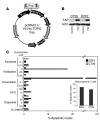Targeting tumor-associated fibroblasts improves cancer chemotherapy by increasing intratumoral drug uptake
- PMID: 16794736
- PMCID: PMC1481657
- DOI: 10.1172/JCI26532
Targeting tumor-associated fibroblasts improves cancer chemotherapy by increasing intratumoral drug uptake
Erratum in
- J Clin Invest. 2009 Feb;119(2):421
Abstract
Tumor-associated fibroblasts are key regulators of tumorigenesis. In contrast to tumor cells, which are genetically unstable and mutate frequently, the presence of genetically more stable fibroblasts in the tumor-stromal compartment makes them an optimal target for cancer immunotherapy. These cells are also the primary source of collagen type I, which contributes to decreased chemotherapeutic drug uptake in tumors and plays a significant role in regulating tumor sensitivity to a variety of chemotherapies. To specifically kill tumor-associated fibroblasts, we constructed an oral DNA vaccine targeting fibroblast activation protein (FAP), which is specifically overexpressed by fibroblasts in the tumor stroma. Through CD8+ T cell-mediated killing of tumor-associated fibroblasts, our vaccine successfully suppressed primary tumor cell growth and metastasis of multidrug-resistant murine colon and breast carcinoma. Furthermore, tumor tissue of FAP-vaccinated mice revealed markedly decreased collagen type I expression and up to 70% greater uptake of chemotherapeutic drugs. Most importantly, pFap-vaccinated mice treated with chemotherapy showed a 3-fold prolongation in lifespan and marked suppression of tumor growth, with 50% of the animals completely rejecting a tumor cell challenge. This strategy opens a new venue for the combination of immuno- and chemotherapies.
Figures





Similar articles
-
Immunotherapy targeting fibroblast activation protein inhibits tumor growth and increases survival in a murine colon cancer model.Cancer Sci. 2010 Nov;101(11):2325-32. doi: 10.1111/j.1349-7006.2010.01695.x. Cancer Sci. 2010. PMID: 20804499 Free PMC article.
-
Anti-tumor effects of DNA vaccine targeting human fibroblast activation protein α by producing specific immune responses and altering tumor microenvironment in the 4T1 murine breast cancer model.Cancer Immunol Immunother. 2016 May;65(5):613-24. doi: 10.1007/s00262-016-1827-4. Epub 2016 Mar 28. Cancer Immunol Immunother. 2016. PMID: 27020681 Free PMC article.
-
Tumor-specific crosslinking of GITR as costimulation for immunotherapy.J Immunother. 2010 Nov-Dec;33(9):925-34. doi: 10.1097/CJI.0b013e3181f3cc87. J Immunother. 2010. PMID: 20948444
-
[FIBROBLAST ACTIVATION PROTEIN (FAP) AS A POSSIBLE TARGET OF THE ANTITUMOR STRATEGY.].Mol Gen Mikrobiol Virusol. 2016;34(3):90-97. Mol Gen Mikrobiol Virusol. 2016. PMID: 30383930 Review. Russian.
-
The application of the fibroblast activation protein α-targeted immunotherapy strategy.Oncotarget. 2016 May 31;7(22):33472-82. doi: 10.18632/oncotarget.8098. Oncotarget. 2016. PMID: 26985769 Free PMC article. Review.
Cited by
-
Effector T Cells Abrogate Stroma-Mediated Chemoresistance in Ovarian Cancer.Cell. 2016 May 19;165(5):1092-1105. doi: 10.1016/j.cell.2016.04.009. Epub 2016 Apr 28. Cell. 2016. PMID: 27133165 Free PMC article.
-
MEKK1 Regulates Chemokine Expression in Mammary Fibroblasts: Implications for the Breast Tumor Microenvironment.Front Oncol. 2021 Mar 18;11:609918. doi: 10.3389/fonc.2021.609918. eCollection 2021. Front Oncol. 2021. PMID: 33868996 Free PMC article.
-
The role of fibroblast activation protein in health and malignancy.Cancer Metastasis Rev. 2020 Sep;39(3):783-803. doi: 10.1007/s10555-020-09909-3. Cancer Metastasis Rev. 2020. PMID: 32601975 Free PMC article. Review.
-
Cancer-associated fibroblasts: challenges and opportunities.Oncotarget. 2023 Mar 21;14:211-214. doi: 10.18632/oncotarget.28385. Oncotarget. 2023. PMID: 36944189 Free PMC article. No abstract available.
-
CNS tumor stroma transcriptomics identify perivascular fibroblasts as predictors of immunotherapy resistance in glioblastoma patients.NPJ Genom Med. 2023 Oct 26;8(1):35. doi: 10.1038/s41525-023-00381-w. NPJ Genom Med. 2023. PMID: 37884531 Free PMC article.
References
-
- Marincola F.M., Wang E., Herlyn M., Seliger B., Ferrone S. Tumors as elusive targets of T-cell-based active immunotherapy. Trends Immunol. 2003;24:335–342. - PubMed
-
- Cohen S., Regev A., Lavi S. Small polydispersed circular DNA (spcDNA) in human cells: association with genomic instability. Oncogene. 1997;14:977–985. - PubMed
-
- Boehm T., Folkman J., Browder T., O’Reilly M.S. Antiangiogenic therapy of experimental cancer does not induce acquired drug resistance. Nature. 1997;390:404–407. - PubMed
-
- Vitale M., et al. HLA class I antigen and transporter associated with antigen processing (TAP1 and TAP2) down-regulation in high-grade primary breast carcinoma lesions. Cancer Res. 1998;58:737–742. - PubMed
-
- Reed J.C. Apoptosis-targeted therapies for cancer. Cancer Cell. 2003;3:17–22. - PubMed
Publication types
MeSH terms
Substances
Grants and funding
LinkOut - more resources
Full Text Sources
Other Literature Sources
Research Materials
Miscellaneous

